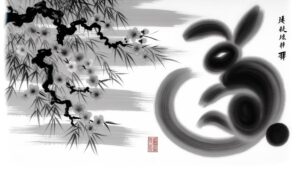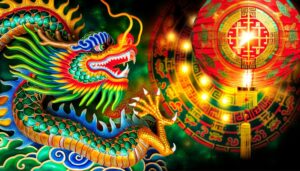How to Draw the Chinese Symbol for Year of the Tiger
The Chinese symbol for the Year of the Tiger (虫) encapsulates profound cultural and historical significance. Rooted in ancient mythology, it represents strength, bravery, and protection, deeply revered within Chinese tradition.
Historically, it symbolized military prowess and authority, particularly during the Zhou Dynasty. The tiger embodies virtues such as courage, leadership, and resilience, which are esteemed in Chinese culture.
This symbol also finds its place in traditional medicine, believed to possess healing properties. Contemporary representations in art and corporate branding underscore its adaptability.
To fully appreciate its multifaceted significance, consider exploring the rich historical and cultural context further.
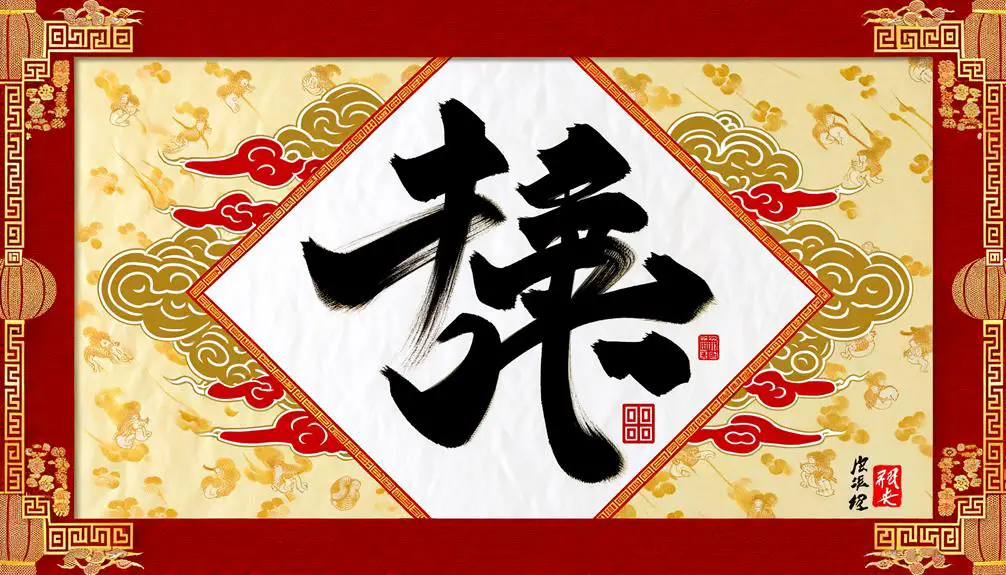
Key Takeaways
- The Year of the Tiger is represented by the Chinese character 虎 (hǔ).
- The tiger symbolizes strength, bravery, and protection in Chinese culture.
- The Year of the Tiger occurs every 12 years in the Chinese zodiac cycle.
- Tigers are revered for their courage, leadership, and authority in Chinese mythology.
- Artistic representations of tigers in the Year of the Tiger highlight their majestic and powerful nature.
Origins of the Tiger Symbol
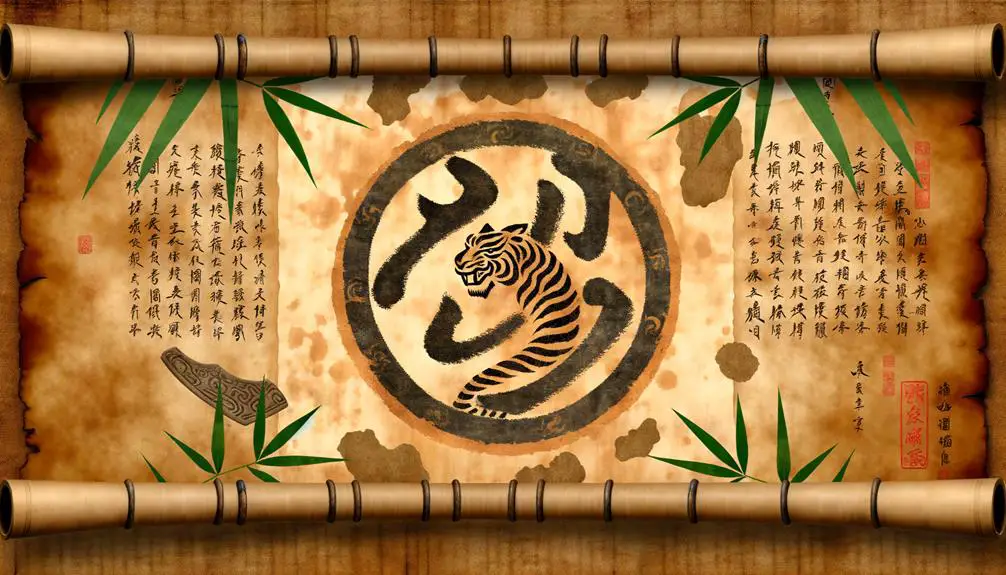
The origins of the tiger symbol in Chinese culture can be traced back to ancient mythology and early dynastic periods, where the tiger was revered as a potent emblem of strength, bravery, and protection. This majestic creature is often associated with the Chinese god of war and is believed to ward off evil spirits.
In mythological narratives, the White Tiger represents the western quadrant of the sky and autumn season, symbolizing power and military prowess. The tiger also appears in various classical texts such as the 'I Ching' and 'Classic of Mountains and Seas,' where its image is imbued with deep spiritual and cultural significance.
Its fierce nature and majestic presence continue to embody essential virtues and protect the Chinese people throughout history.
Historical Significance
Building upon its mythological origins, the tiger symbol has held profound historical significance in Chinese culture, influencing various aspects of societal norms, imperial iconography, and traditional practices over millennia.
During the Zhou Dynasty, the tiger was emblematic of military prowess and was often depicted on armaments and banners to inspire courage among soldiers. In the domain of governance, the tiger symbolized authority and was prominently featured in the regalia of emperors and high-ranking officials.
Additionally, in traditional Chinese medicine, the tiger's physical attributes were believed to possess healing properties, signifying strength and essentiality. The tiger's presence in historical texts and archaeological findings underscores its enduring legacy as a potent symbol of power, protection, and resilience in Chinese civilization.
Cultural Legends
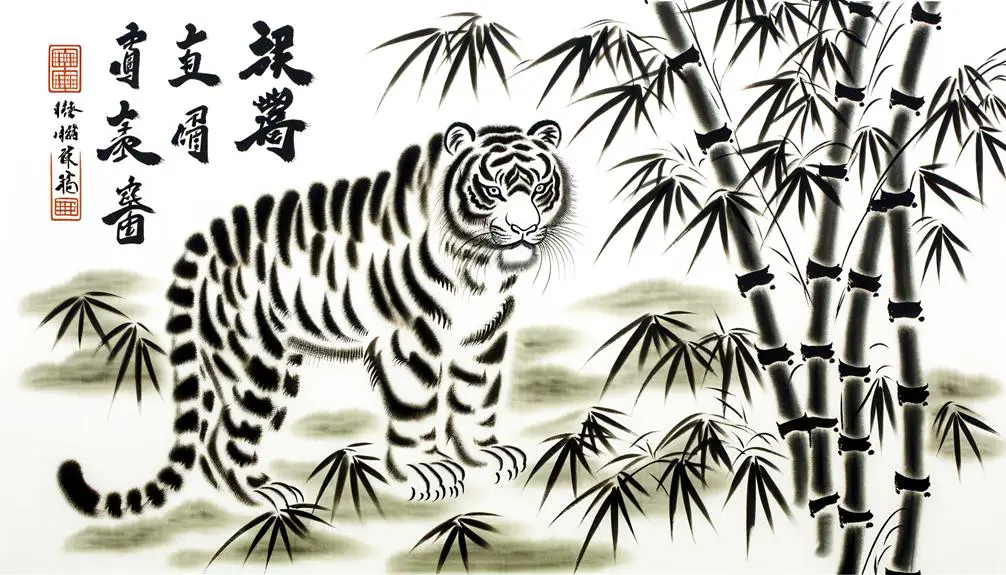
The cultural legends surrounding the Year of the Tiger are rich with mythical stories that illuminate the symbolic meanings attributed to this majestic creature.
In Chinese mythology, the tiger is often depicted as a guardian against evil spirits and a symbol of bravery and power.
These tales not only reinforce the tiger's revered status but also provide insights into the cultural values and beliefs that have shaped its enduring legacy.
Mythical Tiger Stories
Mythical tiger stories, deeply embedded in various cultural legends, offer profound insights into the symbolic significance of the tiger in Chinese mythology.
Renowned tales such as the legend of the White Tiger of the West, one of the Four Symbols in Chinese constellations, depict the tiger as a guardian of metal and a symbol of autumn.
Another fascinating story is that of the tiger who vanquishes evil spirits, embodying the virtues of courage and protection. These narratives not only highlight the tiger's revered status but also reflect its integral role in embodying moral and natural order.
Through these stories, the tiger is immortalized as a powerful totem that commands respect and admiration across generations.
Symbolic Meanings Explained
Cultural legends surrounding the tiger in Chinese mythology reveal a rich tapestry of symbolic meanings, where this majestic creature is often depicted as an emblem of strength, bravery, and protection. In various legends, the tiger is revered not only for its physical prowess but also for its spiritual significance, symbolizing power and authority. The tiger is associated with the earth and is considered a guardian against evil spirits.
| Symbolic Aspect | Meaning |
|---|---|
| Strength | Physical and mental fortitude |
| Bravery | Courage in the face of danger |
| Protection | Guardian against evil forces |
| Authority | Leadership and command |
| Earth Association | Grounding and support |
These attributes make the tiger a powerful symbol in Chinese culture, embodying virtues that are highly esteemed.
Symbolic Meanings
The Chinese symbol for the Year of the Tiger embodies profound connotations of strength and courage, reflecting the tiger's esteemed status as a powerful and fearless predator in Chinese culture.
This symbol also signifies independence and leadership, traits that are highly venerated in both personal and societal contexts.
Understanding these symbolic meanings provides valuable insight into the cultural significance attributed to the tiger, influencing various aspects of Chinese art, literature, and philosophy.
Strength and Courage
Embodying the essence of strength and courage, the Chinese symbol for the Year of the Tiger is deeply rooted in historical narratives and traditional folklore that celebrate the tiger's formidable prowess and indomitable spirit.
In ancient Chinese culture, the tiger is revered as a guardian figure, often depicted as the protector of the domain, warding off evil spirits and ensuring peace. This veneration is evident in art, literature, and martial traditions that emphasize the tiger's attributes of power and resilience.
The tiger's roar is symbolic of assertiveness and bravery, traits that are believed to inspire individuals to confront challenges head-on. Therefore, the Year of the Tiger serves as a reminder of the enduring values of fortitude and valor within Chinese heritage.
Independence and Leadership
In addition to its embodiment of strength and courage, the Chinese symbol for the Year of the Tiger also encapsulates profound themes of independence and leadership, reflecting the tiger's role as a solitary hunter and a natural leader within its environment. These symbolic meanings are deeply ingrained in Chinese culture and offer rich insights into the characteristics attributed to individuals born in this year.
Specifically, the tiger symbolizes:
- Autonomy: Tigers are known for their self-reliance and ability to thrive independently.
- Authority: As apex predators, tigers command respect and embody natural leadership.
- Initiative: Their proactive nature and decisive actions make them exemplars of leadership.
These qualities highlight the tiger's esteemed position in Chinese symbology, emphasizing its role as an independent and authoritative figure.
Personality Traits
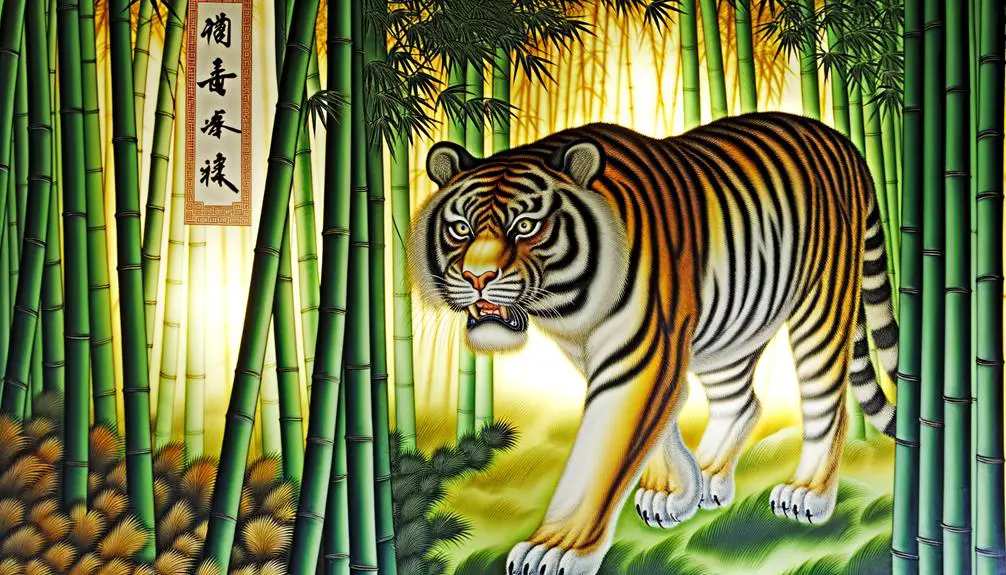
Individuals born in the Year of the Tiger often exhibit a dynamic and courageous personality, marked by an intrinsic drive for adventure and leadership. This intrinsic energy manifests in their willingness to take risks and their ability to inspire those around them. Their innate confidence and assertiveness make them natural leaders who thrive in competitive environments.
Tigers are known for their strong sense of justice and determination, often championing causes they believe in with unyielding fervor. Culturally, these individuals are perceived as charismatic and protective, embodying the fierce yet noble spirit of the tiger. However, their intense nature can sometimes lead to impulsiveness and a tendency to act before thinking, requiring a balance between enthusiasm and prudence.
Celebrations and Traditions
The Year of the Tiger is celebrated with a rich tapestry of traditions and cultural festivities that highlight the significance of this powerful zodiac symbol within Chinese society. These celebrations are imbued with rituals aimed at invoking the tiger's attributes of courage, strength, and protection.
Key traditions include:
- Lion and Dragon Dances: These performances symbolize power and ward off evil spirits, embodying the tiger's protective nature.
- Red Envelopes: Elders gift red envelopes containing money to younger generations, a practice believed to bring luck and prosperity.
- Feasts and Family Reunions: Elaborate meals featuring symbolic foods are shared, reinforcing familial bonds and honoring ancestors.
These customs not only celebrate the tiger but also strengthen communal and familial ties.
Tiger in Modern Times

Amidst the rapid modernization of Chinese society, the symbolism of the tiger continues to resonate, adapting to contemporary contexts while maintaining its cultural significance.
The tiger, emblematic of bravery, strength, and resilience, now finds new relevance in urban narratives and popular media. It embodies the spirit of innovation and determination, qualities essential in today's fast-paced economic environment.
The tiger's image is frequently employed in branding and marketing, signifying power and competitiveness. Additionally, it serves as a metaphor for leadership in corporate discourses, inspiring individuals to harness their inner strength.
The tiger remains an enduring symbol, seamlessly integrating into modern Chinese culture while preserving its time-honored heritage.
Artistic Representations
Artistic representations of the tiger in Chinese culture have evolved over centuries, reflecting both historical contexts and contemporary aesthetics. Traditional ink paintings often depict the tiger as a symbol of power and protection, set against natural landscapes. In contrast, modern interpretations may incorporate vibrant colors and abstract forms, emphasizing the tiger's dynamic energy.
Key artistic representations include:
- Traditional Ink Painting: A medium that captures the tiger's majestic and fierce nature through fluid brushstrokes.
- Sculpture and Ceramics: Three-dimensional forms that embody the tiger's physical prowess and spiritual significance.
- Contemporary Visual Arts: Incorporates mixed media and digital formats, reflecting modern perspectives on the tiger's cultural symbolism.
These varied artistic forms highlight the tiger's enduring significance and adaptability within Chinese art.
Conclusion
The Chinese symbol for the Year of the Tiger encapsulates timeless traditions, cultural continuity, and complex characteristics.
Historical heritage and heroic legends highlight the tiger's revered role, while symbolic meanings manifest in myriad forms—bravery, boldness, and benevolence.
Celebrations and customs commemorate this majestic creature, contributing to contemporary cultural consciousness.
Artistic representations further authenticate the tiger's esteemed status, fostering a fascinating fusion of past and present.
Consequently, the tiger remains a significant symbol of strength and spirit in Chinese culture.


